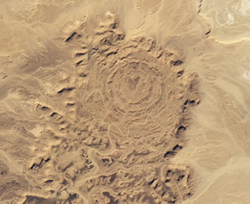When you look at the Moon, you see a surface covered in craters. Yet the Earth, which is bigger and has more gravity – and therefore, you’d think, be hit more often than the Moon – hardly has any craters!
The difference, of course, is that the Earth has weather and tectonic activity. Craters erode, and over time go away*. But not all of them do. Some are so big they take hundreds of millions of years to erode, while others are in dry climates where erosion is limited… like, say, in Algeria. Where the Tin Bider crater lies!
This picture, from the Earth Observatory-1, shows the roughly 6 km (4 mile) wide crater, located in the high desert of northern Africa. It has a complicated terraced structure, indicating that the rock inside may have slumped after impact – a common feature in larger craters. It has undergone some erosion, too… not surprising, given its age of about 70 million years!
 There’s an interesting thing about this crater. North is up in the picture, so the sunlight is coming from the south, from the bottom of the picture. Regular readers of this blog know that this induces the well-known crater/dome illusion (another example can be found here). Our brains expect light to come from above, so when it comes from below the shadows send mixed signals to our brains, and we interpret craters as domes and vice-versa.
There’s an interesting thing about this crater. North is up in the picture, so the sunlight is coming from the south, from the bottom of the picture. Regular readers of this blog know that this induces the well-known crater/dome illusion (another example can be found here). Our brains expect light to come from above, so when it comes from below the shadows send mixed signals to our brains, and we interpret craters as domes and vice-versa.
This illusion plays into this crater, because it’s actually raised above the surrounding plains! It’s still a crater, but it sits up higher than the desert around it. In the smaller picture above I flipped the picture over, and you may see that the crater now looks like it’s above the plains. I know some people have a hard time seeing this illusion, so for proof here is a topographical map of the region, from Earth Impact Database:
See? Blue represents low regions, red high. The crater is higher up! I’m thinking the area of the crater may have been uplifted over time, raising it above everything around it. Weird, huh? They also have an oblique 3D view that again shows it raised up. Amazing!
As always, it goes to show that you can’t always trust your eyes. It also shows me that there are interesting features on our own planet I hadn’t even heard of. But that, to me, is good news. There’s so much left to see and explore!
Image credits:EO-1 image created by Jesse Allen, using EO-1 ALI data provided courtesy of the NASA EO-1 team. Topographic image provided by Dr. Carlos Roberto de Souza Filho for the EID.
* We also have an atmosphere which keeps anything smaller than a hundred meters across from hitting us, but those make craters on the order of a kilometer or two in diameter; it takes a decent telescope to even see such craters on the Moon.
Related posts:
- More Mars caves found
- Google Moon
- Radar love
- A lunar illusion you’ll flip over